Are you looking to start growing, Jasmine? That’s why this guide is for you —to provide a step-by-step guide that will walk you through the entire process. Firstly, the Jasmine variety is to be selected, along with the right soil conditions, climate, location, and care for the plants before the flowers can be harvested. This guide will make sure you don’t miss any essential steps.
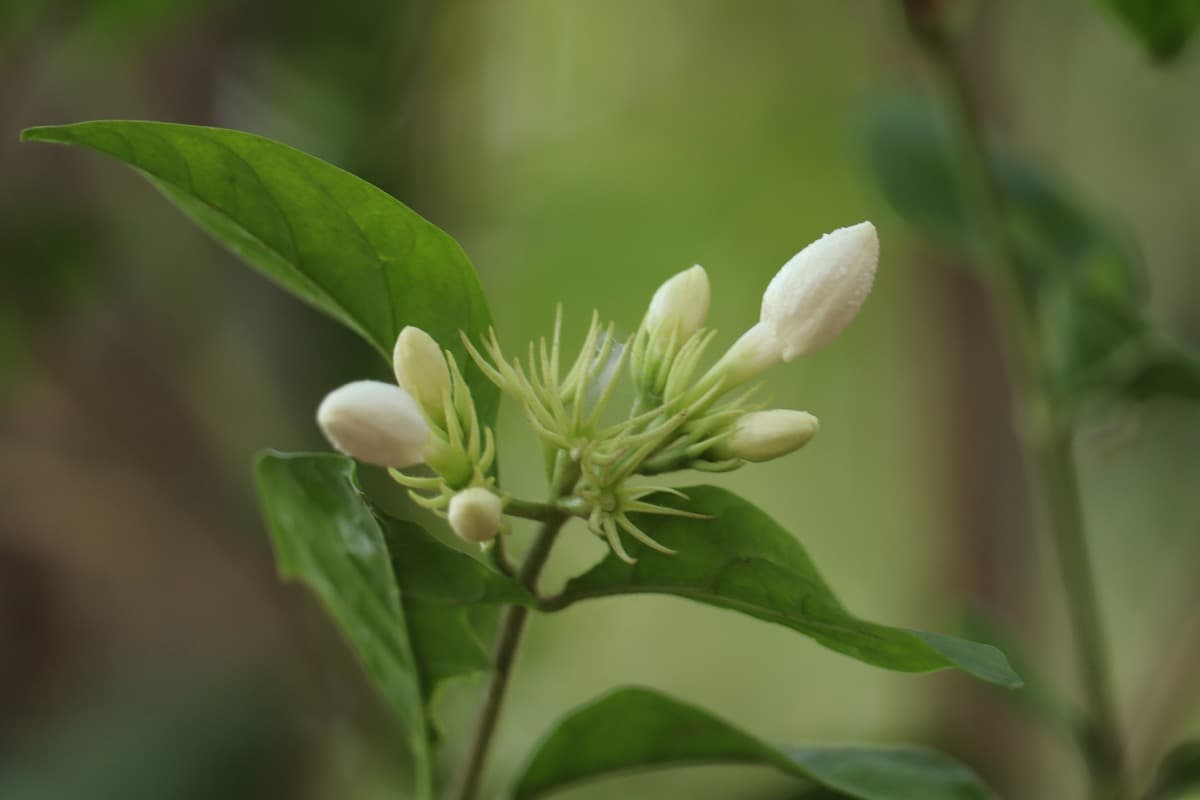
Kerala is renowned for its abundance of jasmine crops, as it is the country’s 11th largest producer of Jasmine. However, setting up a jasmine farm from scratch can be daunting for inexperienced beginners. With our guide, you’ll be able to get your jasmine farm up and running in no time. So, if you’re ready to start, read on to learn how to create a successful jasmine farm in Kerala.
How to start Jasmine (Mogra) farming in Kerala
Introduction to Jasmine
Jasmine is a fragrant flower grown for its distinct aroma. With the proper care and maintenance, jasmine farming can be highly profitable. Jasmine plants grow to around 2m or 3 to 4.5 m if planted as a vine, and their flowers are about 30 cm long. 5-9 leaflets, each up to 6 cm long, are present on the oval, deep green leaves. The leaves of the jasmine flower are either deciduous (falling in the autumn) or evergreen (which means the leaves are green all year).
While some species spread out or rise, others stand tall. The flowers are about 2.5 cm in diameter and have white and yellow colouring. However, certain species have extraordinarily reddish colouring. The blossoms have at least three flowers and are carried in cymose clusters. Jasmine is in bloom and has berry-shaped fruits, which turn black when ripe.
Important varieties for growing Jasmine in Kerala
Several jasmine species are grown as ornamental plants. The most suitable species for growing in Kerala is Jasminum sambac. Some Species and cultivars grow trailing, ascending, and erect. The following are three essential species and their varieties:
- Jasminum sambac: Gundumalli, Motia, Virupakshi, Sujimalli, Madanabanam, Ramabanam.
- Jasminum grandiflorum: Thimmapuram, Lucknow, Co-1 Pitchi, Co-2 Pitchi
- Jasminum auriculatum: Co-1, Co-2, Long Point, Long Round, Short Point, Short Round
In case you missed it: How To Buy Agricultural Land In Kerala
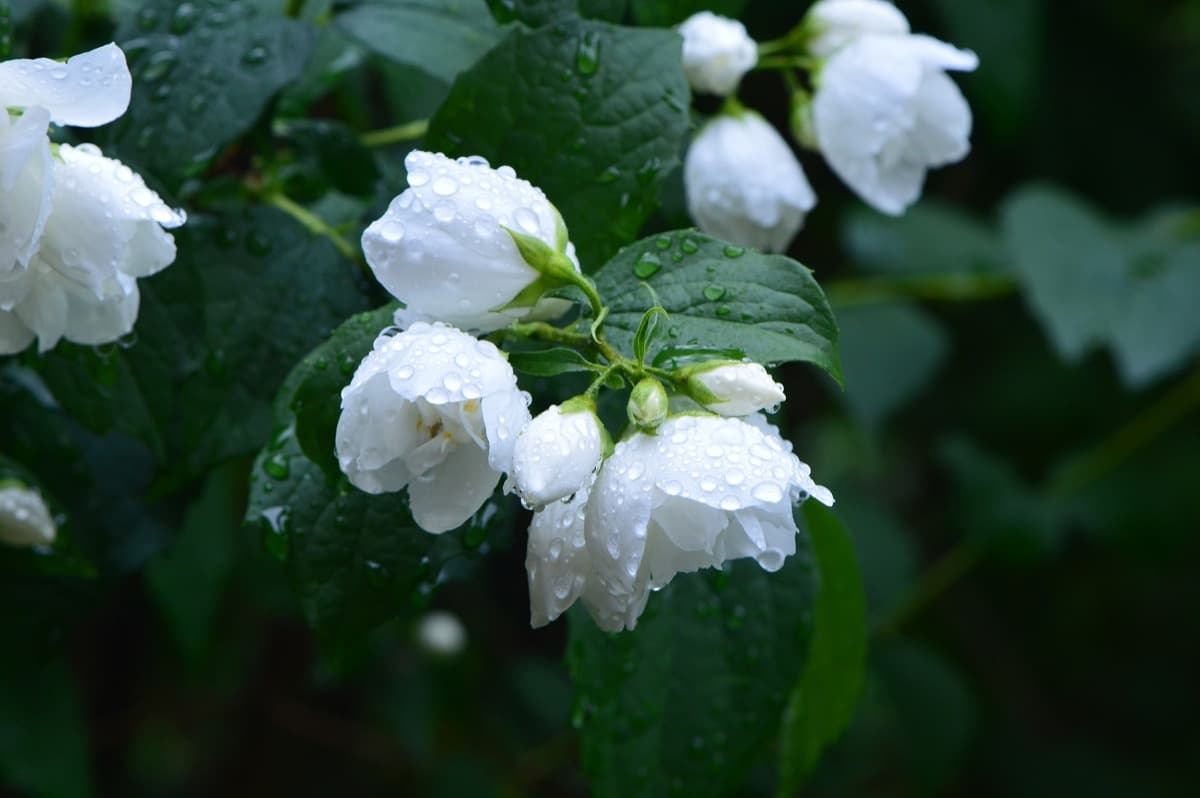
Climate conditions required for Jasmine cultivation in Kerala
Jasmine prefers mild and tropical climates. Jasmine is commercially grown in India in open field conditions. Mild winters, warm summers, light rainfall, and bright days are optimal for jasmine cultivation. Jasmine can grow well up to 1200 meters at altitude. A well-distributed yearly rainfall of 800 to 1000 mm is ideal for growth and development.
Soil preparation for Jasmine farming
Jasmine may be grown in a variety of soil types. It grows best in well-drained sandy loams and red loams. There is more vegetative growth and less flowering in clayey soils. Under low rainfall conditions, they produce a good yield. The first step is to conduct a soil test to determine the composition of the soil.
The soil should be highly fertile and well-draining, and any additional nutrients or amendments should be added as needed. Before planting, you should also ensure the pH is between 6.0 and 6.8. The soil must also be tilled by removing any rocks, debris, weeds, and other plants. After ploughing, the 40x40x40 cm pits are made for seedlings.
Propagation material for Jasmine farming in Kerala
Jasmine can be grown from seeds, cuttings, layers, sucker plants, grafts, budding plants, and tissue cultures. Layering is done in Kerala from June to December. Layers are prepared by selecting well-matured, one-year-old shoots and burying them 10-15 cm deep in the soil after cutting a shallow, slanting cut in the area to be buried. Root development takes 90–120 days. Cuttings are also an option for propagating Jasmine. Typically, 22–25 cm long cuttings with 3–4 nodes are put in the rooting material.
Cuttings collected from April to September have the best proportion. Rooting rates are highest for June planted cuttings. Before planting, the basal section of softwood cuttings is treated with growth-controlling agents (IBA 400 ppm and IAA 1000 ppm) to promote rooting. The cuttings are immersed in the rooting medium more than 5 cm deep and spaced 7 cm apart. Cuttings should be watered regularly until the roots form. Both vegetative seedlings and cuttings can be planted directly in the soil or transplanted after they take root.
Seed germination in Jasmine
Before planting, the seeds should be stratified for about a week in a cool, dry place. This will help increase the germination rate. Once ready, the seeds should be sown in a seedbed and lightly covered with soil. The seedbed should be regularly watered, ensuring that the soil remains moist. If direct sowing is done, the seeds should be spaced out appropriately to allow the plant to spread. Proper care should be taken to ensure that the seedlings are not damaged. The seedlings will soon mature into healthy and productive plants with proper care and management.
In case you missed it: District Wise Crop Production in Kerala: Major Crops in Kerala
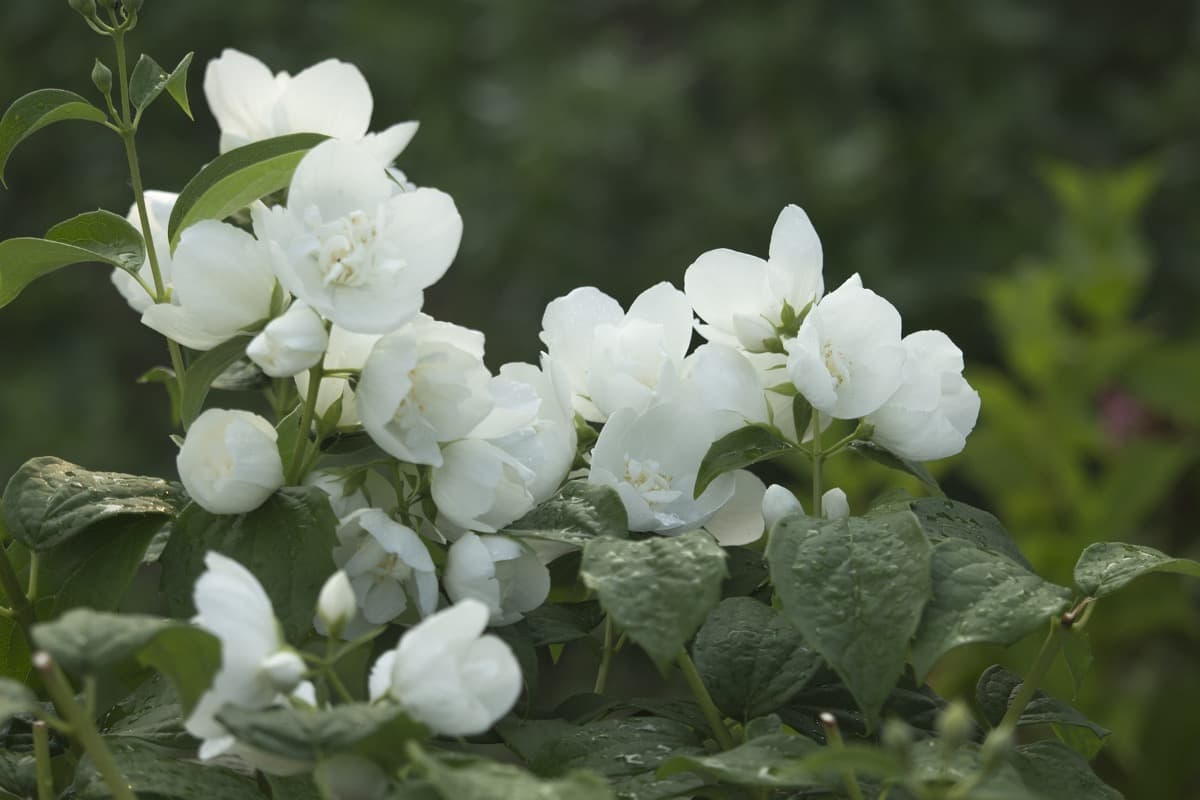
Planting spacing in Jasmine farming in Kerala
Before planting, you must consider the area’s temperature and soil conditions. Planting distance: Experts recommend a planting distance of 1.5 x 1.5 m; 2.0 x 1.5 m is ideal. The optimum time to plant Jasmine is during the monsoon season; once planted, the Jasmine remains in the field for 10–15 years. At the same time, the planting season in Kerala is from June to August.
Choosing a suitable area with good sunlight and well-drained soil is essential. Make sure to remove any weeds and loosen the soil before planting. After that, cut the jasmine cuttings to the desired length and plant them in the soil. Water the jasmine cuttings regularly and make sure to provide adequate sunlight. Finally, use the right fertilizer to provide nutrients to the soil.
Mulching operation in Jasmine Cultivation
Mulching is an essential step in jasmine farming. Mulch is a layer of organic material placed around the jasmine plant’s base. It is used to help retain moisture and control weeds. It also helps to keep the soil temperature and pH level consistent. Straw, leaves, grass, hay, and other organic materials can be used in jasmine farming.
These organic mulches help to draw beneficial insects and worms to the soil, which helps to aerate it and promote healthy plant growth. Inorganic mulches such as gravel, plastic, and newspaper can also be used. When using mulch for jasmine farming, it is essential to keep the mulch layer at least two inches away from the base of the plants.
Pruning in Jasmine
Pruning is necessary and should be done at 45 cm above ground height from December to January.
Intercropping in Jasmine farming
Intercropping is an excellent technique for growing Jasmine. By intercropping Jasmine with other crops, such as spices and vegetables, farmers can better utilize the land and increase the overall yields of their jasmine crop. Additionally, it helps to provide additional benefits to the soil by increasing nutrient density and improving soil fertility.
Intercropping also helps to reduce pest and disease damage, as the different crop species help to repel pests and provide natural protection from diseases. It also helps to reduce labour costs as well as the overall maintenance of the jasmine crop. It is an effective way for farmers to maximize the yield of their jasmine crops.
Weed management in Jasmine farming in Kerala
Weed management is an essential aspect of intercultural operations. Jasmine farming can suffer from pest and disease issues without proper weed management, leading to reduced yields and profits. To ensure a successful jasmine crop, weeds should be controlled through a combination of manual and chemical methods. The manual method involves removing weeds by hand or using tools such as hoes or machetes.
Chemical methods include the use of herbicides. All of these techniques should be combined to maximize weed management’s efficiency. Additionally, crop rotation should be practised to reduce weed pressure, and mulching should reduce soil moisture and temperature. With proper weed management, jasmine farming in Kerala can be profitable and sustainable.
In case you missed it: Top Agricultural Colleges in Kerala: Government and Private
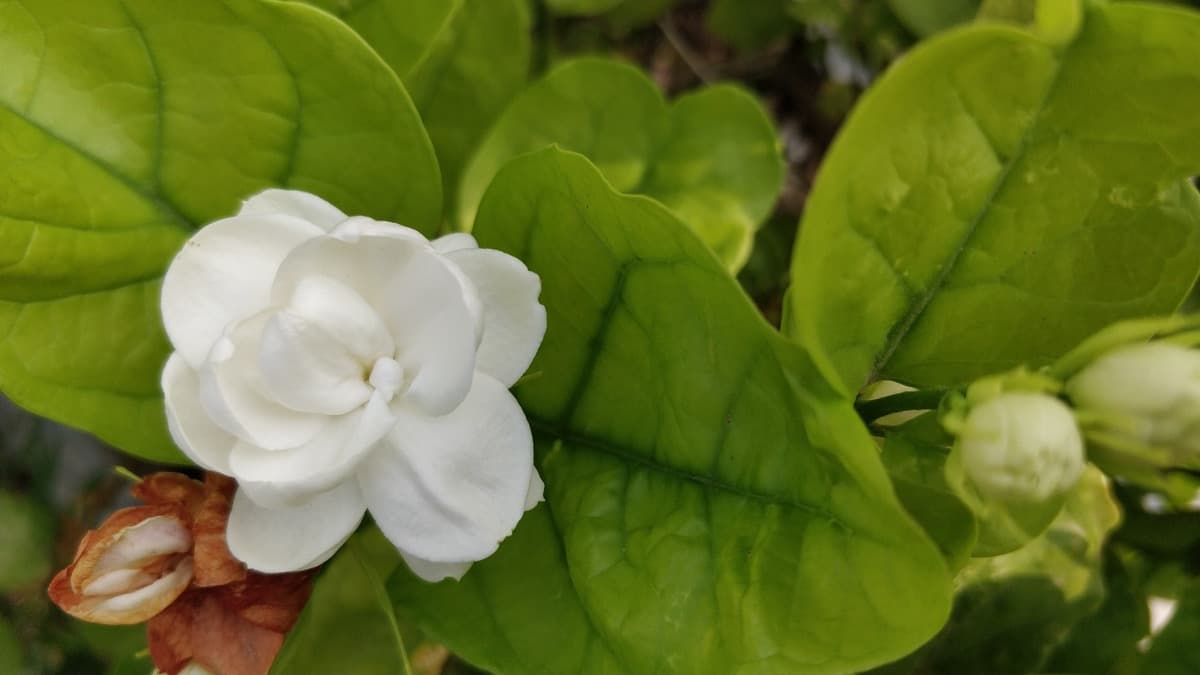
Nutrient management for Jasmine farming
Nutrient management is a crucial component. The ideal soil for jasmine farming should have an adequate nitrogen level and other micronutrients such as phosphorus, potassium, and magnesium. The soil must also provide enough organic matter to keep the soil moist and provide adequate drainage. For jasmine farming with adequate nutrient levels, it is essential to use a balanced fertilizer certified or labelled for the particular crop. Additionally, the soil should be tested to ensure that the right fertilizer is applied to the soil.
| Variety | N (grams/plant) | P205 (grams/plant) | K20 (grams/plant) |
| J. auriculatum | 100 | 200 | 200 |
| J. grandiflorum | 120 | 240 | 240 |
| J. sambac | 100 | 240 | 240 |
Before flowering, spray with zinc 0.25% and magnesium 0.5% to boost floral yield. FeSO4 at 5 g/liter is sprayed monthly to treat Fe deficiency until the chlorotic symptoms fade. With proper nutrient management, jasmine farmers can ensure that their plants receive the proper nutrients to support their growth and production.
Water management in Jasmine farming in Kerala
Jasmine farming requires proper water management for successful growth. In areas with high rainfall, farmers should avoid any water-logging, as it can lead to root rot. Areas with lower rainfall should receive proper irrigation from overhead sprinklers or drip irrigation. Good drainage systems in areas with heavy rains to prevent water logging.
The flowering season (March-October) is critical for a large flower yield. In the summer, plants are irrigated by flooding once a week. Regular irrigation is only required after flowering, trimming, and manuring. Proper fertilization and supplementing the soil with organic matter help to maintain soil fertility and provide the required nutrients for Jasmine to grow.
Disease management in Jasmine farming in Kerala
Common diseases found in jasmine plants include leaf spots, rust, anthracnose, and wilt. Therefore, it is essential to regularly inspect the plants and apply appropriate fungicides to manage these diseases. Organic fungicides are recommended over synthetic fungicides whenever possible. Management of root rot: Apply 2.5 g/liter of copper oxychloride to the soil surrounding the plant. 0.75 g/liter Trifloxystrobin plus Tebuconazole or 0.5 g/liter Difenoconazole is to be applied to the soil.
Foliar use of Mancozeb at 2.5 g/l or Azoxystrobin at one g/l for treating Alternaria leaf spots. After planting, apply Pseudomonas fluorescens to the soil at 25 g/m2 and the leaves. Additionally, proper sanitation practices such as regular pruning and removing infected plant parts can aid in disease prevention. Lastly, proper irrigation and fertilization practices can help ensure the plants’ health.
In case you missed it: Poultry Farming In Kerala – How To Start
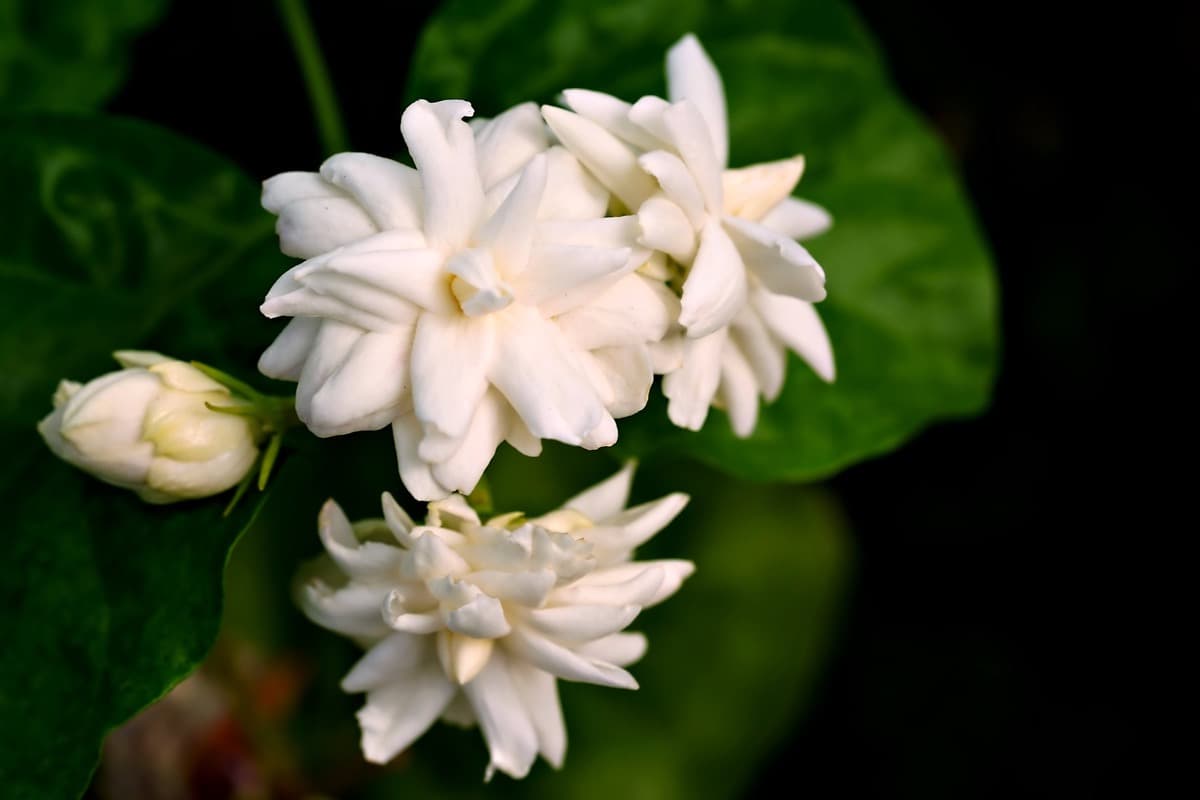
Insect pest Management in Jasmine farming in Kerala
Insect pests are a major threat to jasmine farming in Kerala. The three most significant ones are the flower midge (Contarinia maculipennis), leaf webber (Nausinoe geometralis), and budworm (Hendecasis duplifascialis), among others. In addition, drought and hot weather caused the mite (Tetranychus urticae) to attack. The budworm is among the insect pests that have been identified as being particularly dangerous to flower production.
In addition, pests such as mites, aphids, thrips, and whiteflies can commonly be found in jasmine plants. To protect the crop from infestation, farmers must take preventive measures such as using insecticides, natural predators, and handpicking. Integrated pest management (IPM) is an effective way to reduce the damage caused by these pests.
IPM involves monitoring the jasmine plants for pest activity and applying appropriate control measures. Farmers must also practice crop rotation and keep the crop safe from infestation. Organic and natural pest control methods, such as neem oil, garlic, and chilli sprays, are also effective. In addition, other preventive measures, such as using organic fertilizers and biological control agents and avoiding overfertilization, can help reduce pest infestations.
Harvesting and storage of Jasmine
Harvesting and storing Jasmine is an integral part of the jasmine farming process. Flowers should be harvested in the early morning when they are at their peak of flowering and fragrance. Because they are the most fragrant in the morning. Total production begins after grafting in the second year. The flowers should be spread out in an airy, well-ventilated area and kept away from direct sunlight.
The flowers should be handled carefully to preserve their scent and quality. Proper storage of jasmine flowers is essential to maintaining their freshness and quality for an extended period. Jasmine farming in Kerala is becoming increasingly popular among new farmers. The beautiful flower is known for its sweet-smelling fragrance and is used in many religious ceremonies. Here are some tips on storing Jasmine:
- Keep the jasmine flowers dry and separate from other flowers.
- Ensure that the jasmine flowers are kept in a cool, dry place.
- Do not keep the jasmine flowers in a plastic bag or container, as it may cause them to sweat and rot.
- Keep jasmine flowers away from direct sunlight as it can affect their quality and life.
- Use nitrogen-based gases to avoid oxygenation and keep the flowers fresh for a long time.
- If you are storing Jasmine for longer, use a vacuum sealer to ensure the flowers stay fresh.
In case you missed it: State Wise Tomato Farming Seasons in India: Growing Best Varieties and Production Yield
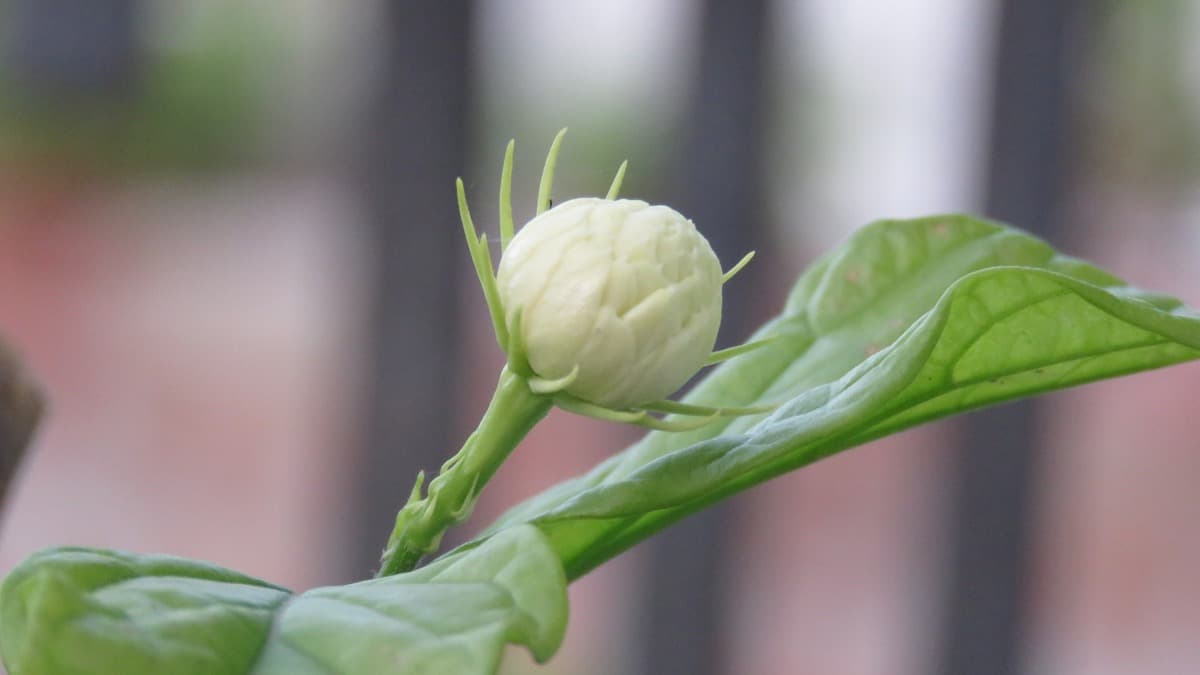
Jasmine marketing in Kerala
To market Jasmine successfully in Kerala, it is vital to understand the local market and keep up with the latest trends and flower market pricing. It is also essential to maintain contact with local florists and flower sellers. Establishing a good rapport with them can open up new product marketing opportunities. Furthermore, participating in flower shows and exhibitions is a beautiful way to stand out in the market.
Finally, forming cooperative societies and partnerships can help strengthen the product’s presence in the market. One of the most efficient modern marketing methods is using online promotional channels. Websites, blogs, and social media channels can be used to create awareness about the product. Additionally, organizing seminars and workshops can help disseminate information to potential customers if flowers are of premium quality to fetch the best price.
The bottom line for Jasmine farming in Kerala
Jasmine farming makes it an excellent crop for those looking to profit while impacting their local community. If you’re interested in getting started, here’s a step-by-step guide to help you get started. First, obtain a soil test report to cultivate Jasmine. This will allow you to grow the crop in your area judiciously.
Next, decide on a site for your jasmine farm. Second, ensure the area has plenty of sunlight and is free from pests. Third, purchase the seeds or seedlings from a nearby nursery and carefully follow the instructions. Once planted, the jasmine plants should be regularly watered, weeded, and fertilized. Lastly, ensure to harvest the flowers in the morning when the aroma is most potent.
- Types of Pesticides Used in Agriculture: A Beginner’s Guide
- Economical Aquaculture: A Guide to Low-Budget Fish Farming
- 15 Common Planting Errors That Can Doom Your Fruit Trees
- How to Make Houseplants Bushy: Effective Tips and Ideas
- Innovative Strategies for Boosting Coconut Pollination and Yield
- Pollination Strategies for Maximum Pumpkin Yield
- The Complete Guide to Chicken Fattening: Strategies for Maximum Growth
- Natural Solutions for Tulip Problems: 100% Effective Remedies for Leaf and Bulb-Related Issues
- Revolutionizing Citrus Preservation: Towards a Healthier, Greener Future
- Natural Solutions for Peony Leaf and Flower Problems: 100% Effective Remedies
- Maximizing Profits with Avocado Contract Farming in India: A Comprehensive Guide
- Natural Solutions for Hydrangea Problems: 100% Effective Remedies for Leaf and Flowers
- The Ultimate Guide to Choosing the Perfect Foliage Friend: Bringing Life Indoors
- From Sunlight to Sustainability: 15 Ways to Use Solar Technology in Agriculture
- The Ultimate Guide to Dong Tao Chicken: Exploring from History to Raising
- The Eco-Friendly Makeover: How to Convert Your Unused Swimming Pool into a Fish Pond
- Mastering the Art of Delaware Chicken Farming: Essentials for Healthy Backyard Flocks
- 20 Best Homemade Fertilizers for Money Plant: DIY Recipes and Application Methods
- How to Craft a Comprehensive Free-Range Chicken Farming Business Plan
- Brighten Your Flock: Raising Easter Egger Chickens for Beauty and Bounty
- How to Optimize Your Poultry Egg Farm Business Plan with These Strategies
- Subsidy for Spirulina Cultivation: How Indian Government Schemes Encouraging Spirulina Farmers
- Ultimate Guide to Raising Dominique Chickens: Breeding, Feeding, Egg-Production, and Care
- Mastering the Art of Raising Jersey Giant Chickens: Care, Feeding, and More
- Ultimate Guide to Raising Legbar Chickens: Breeding, Farming Practices, Diet, Egg-Production
- How to Raise Welsummer Chickens: A Comprehensive Guide for Beginners
- How to Protect Indoor Plants in Winter: A Comprehensive Guide
- Ultimate Guide to Grow Bag Gardening: Tips, Tricks, and Planting Ideas for Urban Gardeners
- Guide to Lotus Cultivation: How to Propagate, Plant, Grow, Care, Cost, and Profit
- Agriculture Drone Subsidy Scheme: Government Kisan Subsidy, License, and How to Apply Online
- Ultimate Guide to Raising Araucana Chickens: Breed Profile, Farming Economics, Diet, and Care
- Bringing Hydroponics to Classroom: Importance, Benefits of Learning for School Students
- Ultimate Guide to Raising Polish Chickens: Breed Profile, Farming Economics, Diet, and Care
- Ultimate Guide to Raising Australorp Chickens: Profile, Farming Economics, Egg Production, Diet, and Care
- Silkie Chicken Farming: Raising Practices, Varieties, Egg Production, Diet, and Care
- Sussex Chicken Farming: Raising Practices, Varieties, Egg Production, Diet and Care
Thank you for your information about. This is very important for me and I’m very interested in your information.